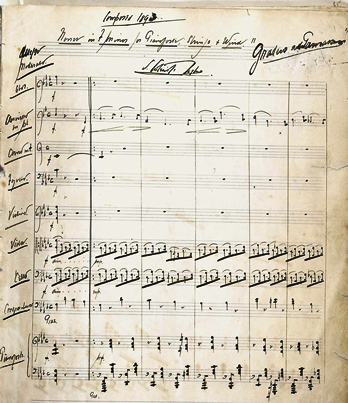Presents
Samuel Coleridge-Taylor
Nonet in f minor, Op.2---New Edition
For Violin, Viola, Cello, Bass, Oboe, Clarinet, Horn, Bassoon & Piano
 Samuel
Coleridge-Taylor was 18 years old and a student at the Royal College of Music in
London when he composed his Nonet during 1893-4. Realizing he was still
a student, he modestly titled his score, (pictured on the left) ‘Gradus ad
Parnassum’ (Steps to Parnassus), suggesting he realised that he still had plenty
to learn. His teacher at the RCM was Charles Villiers Stanford, and the work
reveals the clear influence of Brahms, of whom Stanford admired. The Nonet is
written on a big scale and the work could easily have received the title Grand
Nonet. The first movement, Allegro moderato, is densely written and when all
nine are engaged, the sound often approaches the orchestral. However, this is
juxtapositoned with smaller groups within the Nonet to achieve the more intimate
sound of chamber music. The first subject brought forth by the clarinet is broad
and expansive before the rest of the group join in. A livelier second theme is
then given out by the piano. In the lyrical, song-like second movement, Andante,
one hears echoes of Coleridge-Taylor’s favorite composer, Dvorak. Next comes a
buoyant Scherzo with a nicely contrasting trio section in which the horn is
given the lead. Again, the hand of the Czech master seems to be resting on his
admiring student's shoulders. The opening bars to the ebullient finale,Allegro
vivace, sound as if it is to be a work with piano and orchestra, and what
follows does, in fact, on occasion sound this with its many moods and
instrumental colors.
Samuel
Coleridge-Taylor was 18 years old and a student at the Royal College of Music in
London when he composed his Nonet during 1893-4. Realizing he was still
a student, he modestly titled his score, (pictured on the left) ‘Gradus ad
Parnassum’ (Steps to Parnassus), suggesting he realised that he still had plenty
to learn. His teacher at the RCM was Charles Villiers Stanford, and the work
reveals the clear influence of Brahms, of whom Stanford admired. The Nonet is
written on a big scale and the work could easily have received the title Grand
Nonet. The first movement, Allegro moderato, is densely written and when all
nine are engaged, the sound often approaches the orchestral. However, this is
juxtapositoned with smaller groups within the Nonet to achieve the more intimate
sound of chamber music. The first subject brought forth by the clarinet is broad
and expansive before the rest of the group join in. A livelier second theme is
then given out by the piano. In the lyrical, song-like second movement, Andante,
one hears echoes of Coleridge-Taylor’s favorite composer, Dvorak. Next comes a
buoyant Scherzo with a nicely contrasting trio section in which the horn is
given the lead. Again, the hand of the Czech master seems to be resting on his
admiring student's shoulders. The opening bars to the ebullient finale,Allegro
vivace, sound as if it is to be a work with piano and orchestra, and what
follows does, in fact, on occasion sound this with its many moods and
instrumental colors.
Samuel Coleridge-Taylor (1875-1912) was born in London, the product of a mixed race marriage, his father, a doctor, being an African from Sierra Leone and his mother a white Englishwoman. His father returned to Africa when he was a small boy and he was brought up by his mother in Croydon. His musical talent showed itself early and he was admitted to study the violin at the Royal College of Music where he eventually concentrated on composition when his gifts were ascertained. His teacher was the renowned composer, Sir Charles Villiers Stanford. Stanford immediately recognized his young student's immense talent, later calling him the most gifted of all of the many students he taught that subsequently became famous composers. Not surprisingly, the music shows the influence of the idols of Standford's own teachers--Carl Reinecke and Friedrich Kiel as well as his idol Brahms. Coleridge-Taylor and his compositions gained considerable fame during his lifetime. His oratorio Hiawatha's Wedding Feast for a time became as popular as Handel's Messiah and Mendelssohn's Elijah. He made several visits to the United States because of his interest in American Negro cultural life. His fame was such that he made three visits the United States. On one visit, he was invited to the White House by Theodore Roosevelt. On another, he was asked to conduct the New York Philharmonic. At the time, Mahler was its music director. Coleridge-Taylor's success was such that they nicknamed him the "African Mahler."
While there has been one other edition, it is almost impossible to obtain and dealers are offering it at between for $275 and $375. As musicians ourselves, we have tried to keep the price for our fellow players as reasonable as possible, offering the parts alone for less than $100. The score however is nearly 200 pages in length and this reflects the cost of a set of parts and a score, still $100 less than the other edition, assuming you can even find it. Our edition, edited by senior editors Garik Hayrapetyan and Raymond Silvertrust, is based on the manuscript residing at the Royal College of Music in London. Although an early work, it is not a student work but of professional quality and certainly strong enough to be heard in concert and can be warmly recommended to experienced amateur ensembles.
Parts: $97.95
Parts & Score: $175.95